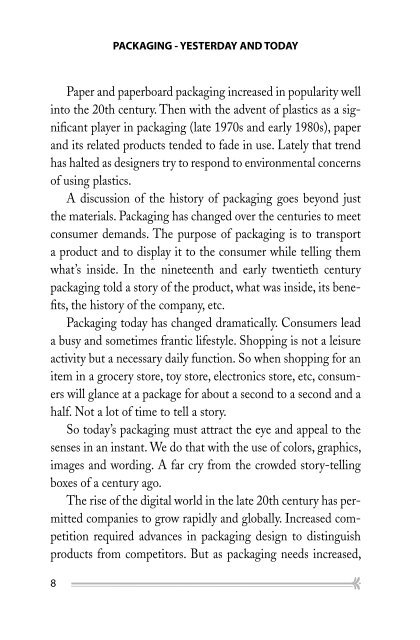The Art of Package Design
There is more to designing a successful package than just making it noticeable. This book explores how to get the most out of the design process and the regulations and legalities required in packaging. It also explores the pitfalls people fall into when trying to create packaging in multi-languages for sale in other markets and cultures. Written by Mark Lehberg, a 30+ year creative professional, this book offers creative insights and tips to create that perfect package.
There is more to designing a successful package than just making it noticeable. This book explores how to get the most out of the design process and the regulations and legalities required in packaging. It also explores the pitfalls people fall into when trying to create packaging in multi-languages for sale in other markets and cultures. Written by Mark Lehberg, a 30+ year creative professional, this book offers creative insights and tips to create that perfect package.
You also want an ePaper? Increase the reach of your titles
YUMPU automatically turns print PDFs into web optimized ePapers that Google loves.
PACKAGING - YESTERDAY AND TODAY<br />
Paper and paperboard packaging increased in popularity well<br />
into the 20th century. <strong>The</strong>n with the advent <strong>of</strong> plastics as a significant<br />
player in packaging (late 1970s and early 1980s), paper<br />
and its related products tended to fade in use. Lately that trend<br />
has halted as designers try to respond to environmental concerns<br />
<strong>of</strong> using plastics.<br />
A discussion <strong>of</strong> the history <strong>of</strong> packaging goes beyond just<br />
the materials. Packaging has changed over the centuries to meet<br />
consumer demands. <strong>The</strong> purpose <strong>of</strong> packaging is to transport<br />
a product and to display it to the consumer while telling them<br />
what’s inside. In the nineteenth and early twentieth century<br />
packaging told a story <strong>of</strong> the product, what was inside, its benefits,<br />
the history <strong>of</strong> the company, etc.<br />
Packaging today has changed dramatically. Consumers lead<br />
a busy and sometimes frantic lifestyle. Shopping is not a leisure<br />
activity but a necessary daily function. So when shopping for an<br />
item in a grocery store, toy store, electronics store, etc, consumers<br />
will glance at a package for about a second to a second and a<br />
half. Not a lot <strong>of</strong> time to tell a story.<br />
So today’s packaging must attract the eye and appeal to the<br />
senses in an instant. We do that with the use <strong>of</strong> colors, graphics,<br />
images and wording. A far cry from the crowded story-telling<br />
boxes <strong>of</strong> a century ago.<br />
<strong>The</strong> rise <strong>of</strong> the digital world in the late 20th century has permitted<br />
companies to grow rapidly and globally. Increased competition<br />
required advances in packaging design to distinguish<br />
products from competitors. But as packaging needs increased,<br />
8



